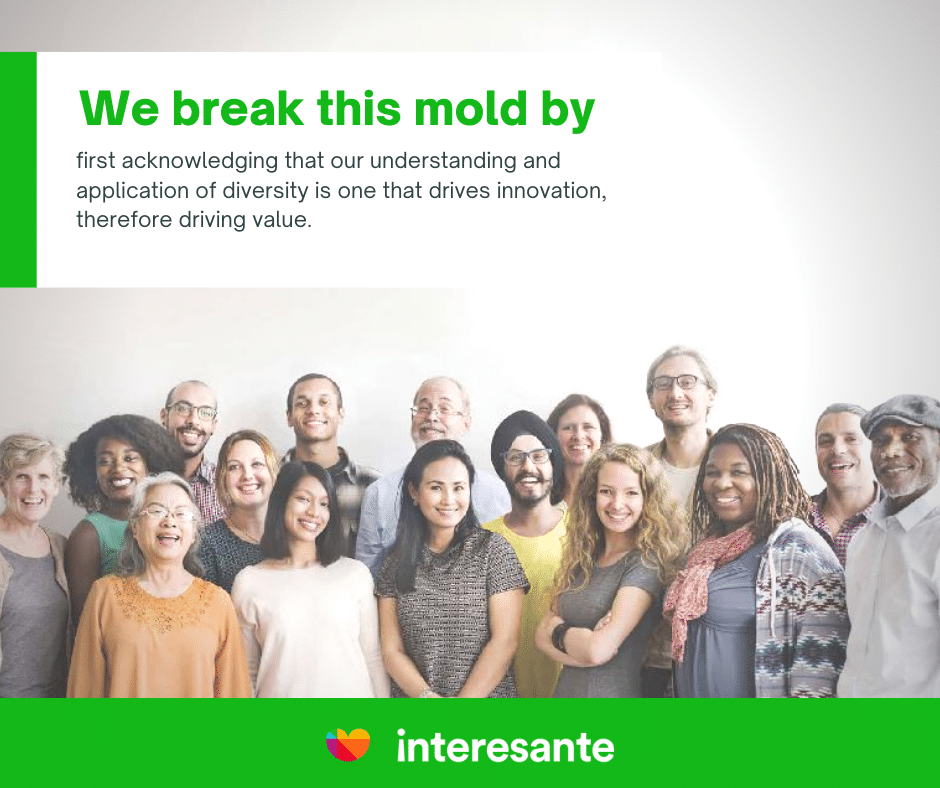Editor-in-Chief @ Interesante
As a diverse team, our collective strength and value arise from our varied backgrounds, beliefs, experiences, and talents.
We embrace diversity, recognizing that it makes us more innovative and versatile in our space. We have observed 5 myths professionals cling to regarding workplace diversity –– and one by one, we debunk them all.
Diversity Myth 1:
Diversity is incompatible with small businesses
A common workplace mentality is that diversity runs counter to the goals of small businesses due the business’s lack of capital/resource, as well as a perception that a diverse team will be less profitable and offer less value.
The perception that diversity is incompatible with small business lies in the false belief that unlike larger corporations, small businesses and startups have the comparable time, capital, and resources to focus on diversity.
Smaller firms are forced to be less holistic in their hiring process. As a result, we see high-functioning small business teams that perform at a standard level since their capacity to innovate is limited by their own homogenous makeup.
We break this mold by first acknowledging that our understanding and application of diversity is one that drives innovation, therefore driving value.
Diversity should not simply be an initiative; diversity should be in your company’s values.
We believe that innovation is a mindset by which the contributions of a multi-dimensional team ultimately offer varying perspectives. These ingenuities lead to better strategic decisions and greater opportunities, surpassing existing constraints that would otherwise bind non-diverse teams.
In turn, by prioritizing diversity as a value, you’ll be able to generate the right kind of innovation.
As such, without diversity, the small business team suffers, as innovation and profit are stifled. To summarize, the lack of capital and resources for small businesses is no excuse to turn a blind eye to the overwhelming benefits of diversity.
In a recent Intel Study, Decoding Diversity: The Financial and Economic Returns to Diversity in Tech, diversity is both profitable and advantageous.
Diversity Myth 2:
It’s impossible to create a team that fulfills all areas of diversity
There are 8 common diversity facets to consider:

In an attempt to fulfill the wide range of diversity criteria, the common approach companies take involves isolating each of the 8 criteria into separate general applications.
This undertaking results in 8 independent diversity initiatives rather than one, all-inclusive program. By siloing criteria for each facet of diversity, any benefits or ROI that a holistically diverse team could generate is diluted.
According to Project Include founder Ellen Pao, it is a dangerously common practice to weigh greater emphasis on the outwardly perceivable facets of diversity, such as race and gender. However, here we argue that it is also important to encompass the “invisible” characterizations of diversity.
Our effort to create a holistically diverse team contributes to our vast repository of precious, creative ideas, and pragmatic implementations.
Diversity Myth 3:
Diversity compromises quality candidates
When hiring minorities, the fundamental assumption often places blame upon the pool of candidates for their skillsets (or lack thereof), rather than examining the number of opportunities available for them in the first place.
A prevalent myth concerns the notion that the number of minority candidates in a given industry correlates to the number of qualified individuals on hand. However, as HuffPost reports, research shows that minorities, when given the opportunity, perform as well as their counterparts in the majority.
The deficient number of minorities in many companies, in fact, results from the overwhelming number of barriers they face, as well as the lack of a pipeline – rather than their “inherent” capabilities.
In pursuing this full-circle diverse team, we have discovered indispensable innovation and value by working with and being supportive of each other’s personal and professional goals.
Diversity Myth 4:
Diversity is inefficient
It is mistakenly viewed as a proponent of inefficiency. This mistaken belief is largely due to the effect that diversity tends to highlight competing solutions, personal abrasions, and conflicts of traditionally swept beliefs under the rug.
Firstly, it is important to clarify how we are defining “inefficiencies.” Although it may appear that abrasions and contrasting ideas initially delay progress, they in fact lead to more innovative and well-developed solutions.
An American Psychological Association study discovered that people tend to be more fact-focused and objective in their decision-making processes when working with team members with varying beliefs and upbringing.
Diversity Myth 5:
Our workplace is already diverse
To fully extract the benefits of diversity requires an understanding beyond an initiative or a checklist.
Simply fulfilling one or two facets of diversity does not constitute a diverse workplace.
Rethink and expand your definition of diversity. We are constantly improving our company’s diversity by making our work environment both welcoming and stimulating for those underrepresented. Innovation at its root is a mindset.
The merging of diverse minds, whether from gender, race, age, or background, provides an edge when it comes to ingenious solutions.
By actively aligning our differences to string ourselves together, we prove that when given the opportunity, everyone can innovate. You’re not only carving a space for companies to capitalize on our innovation and value, but also providing openings for all those seeking a level playing field.
A common goal is the refusal to be shaped by the myths of diversity that our environment presents.
Rather, we discovered that if the environment is not responsive to our diverse team, we must shape our own environment. We value taking care of our employees holistically and support them in their journey to reach both their personal and professional goals. By being open and honest, we empower our team members and partners to take on new leadership initiatives.














